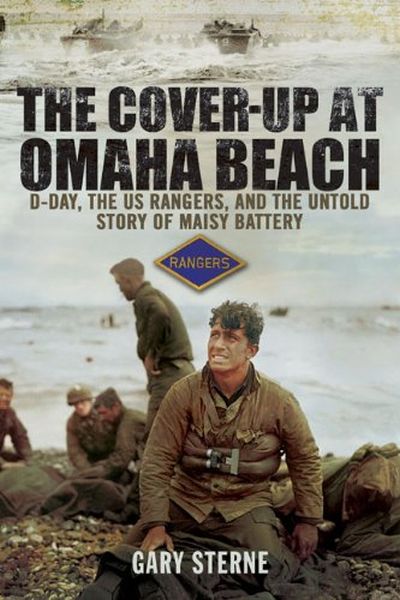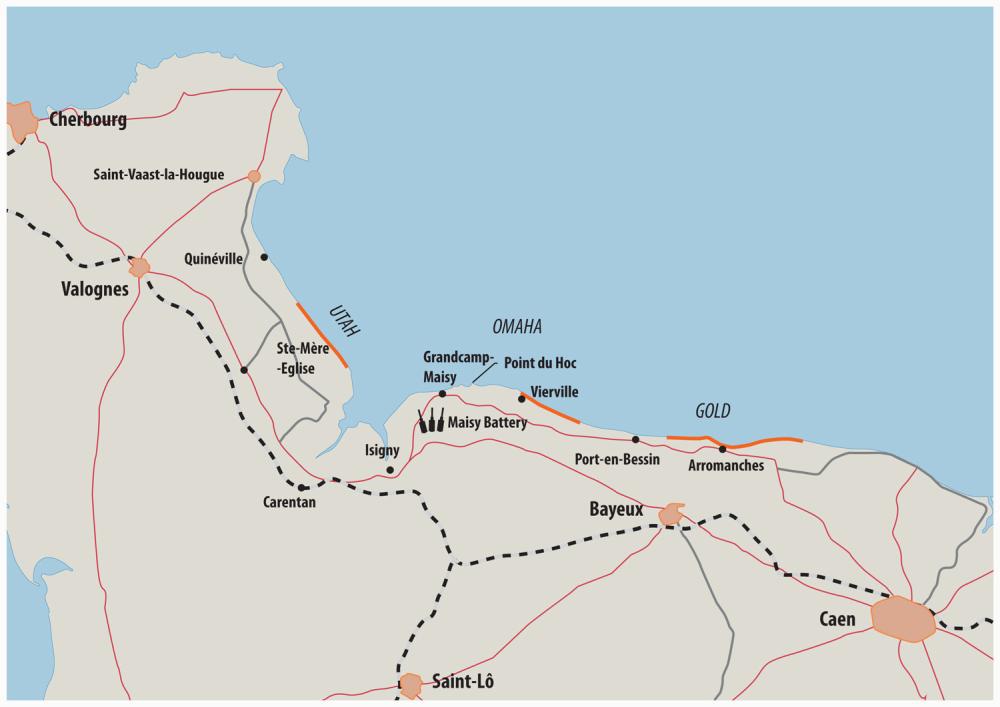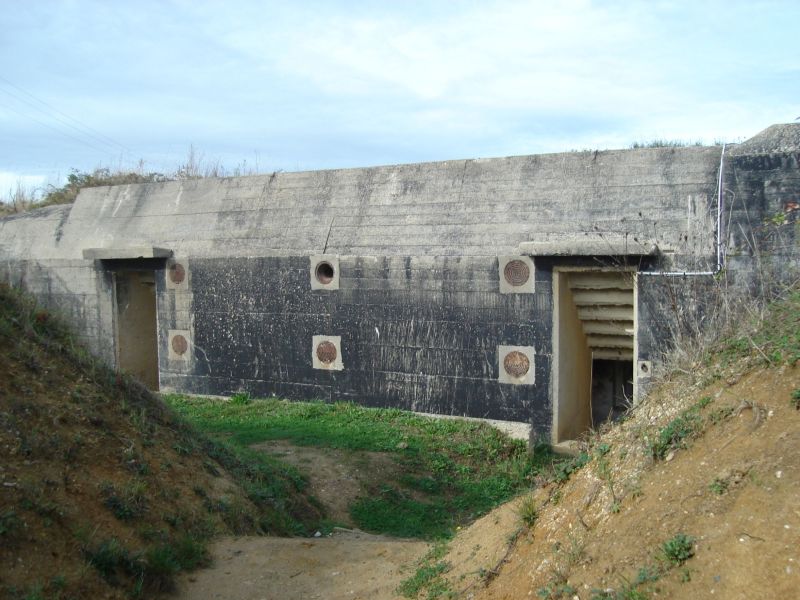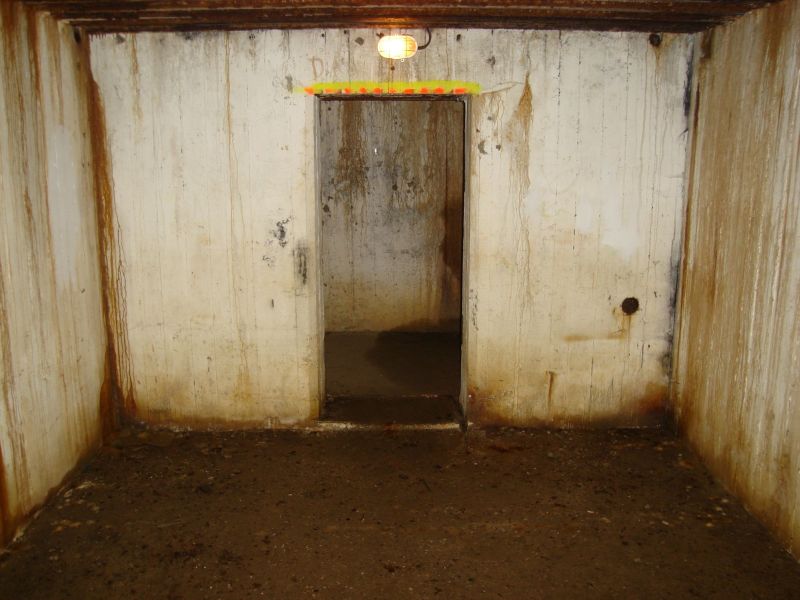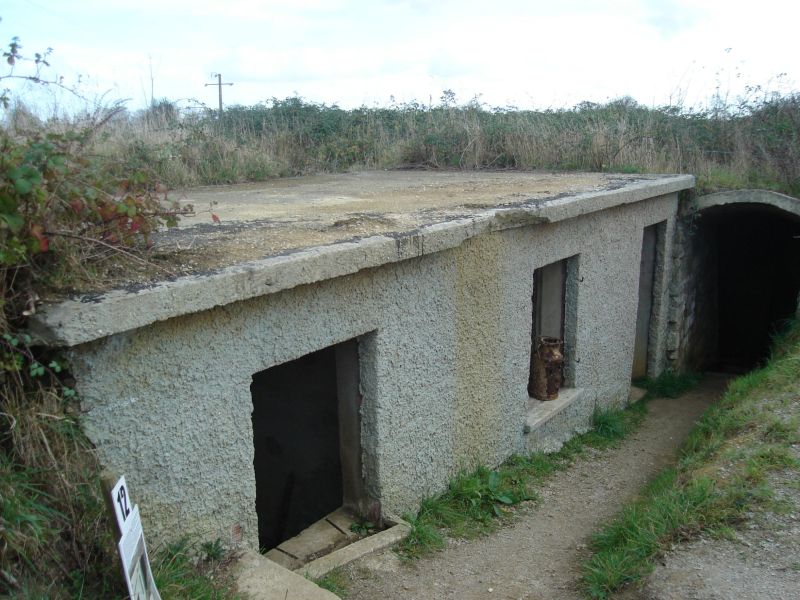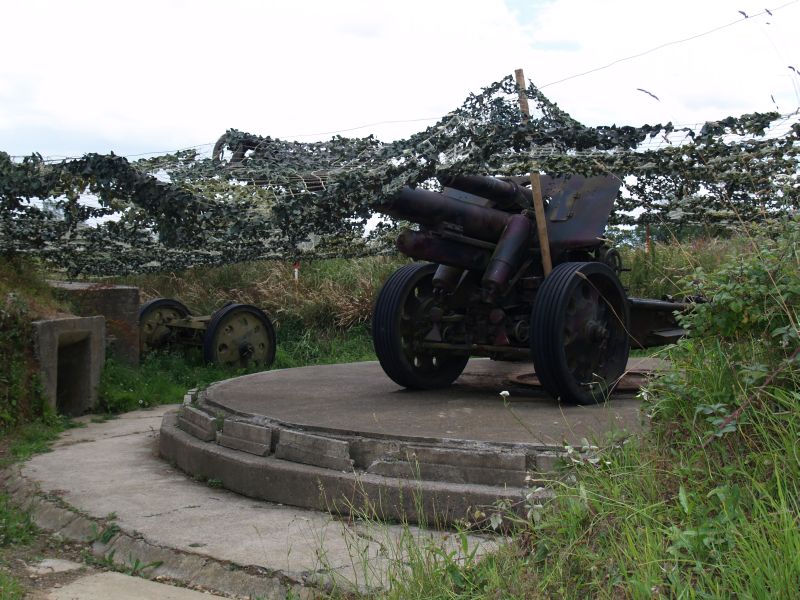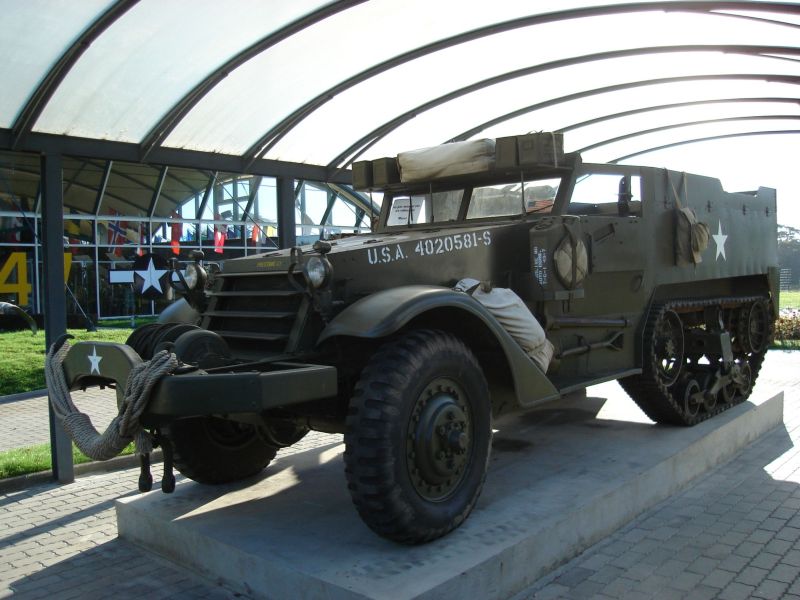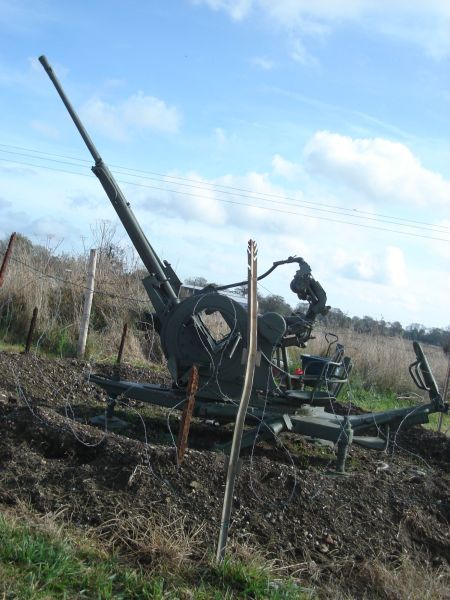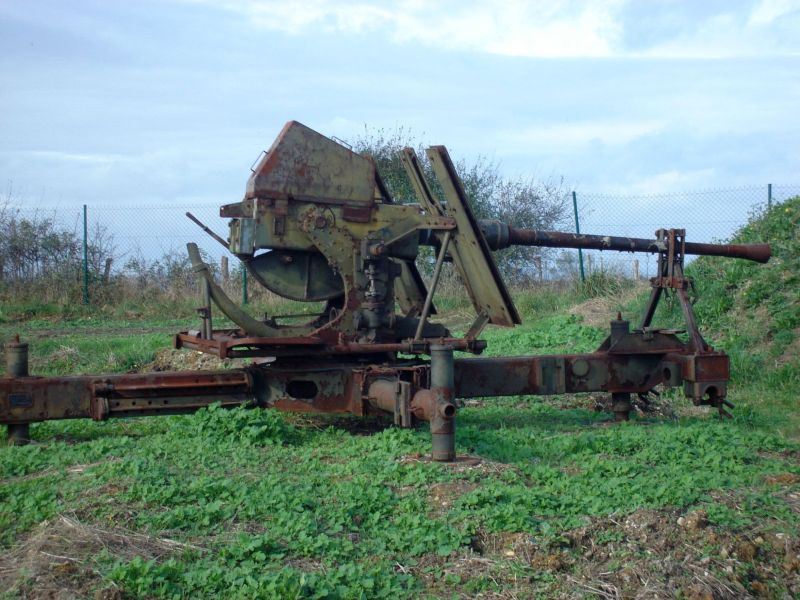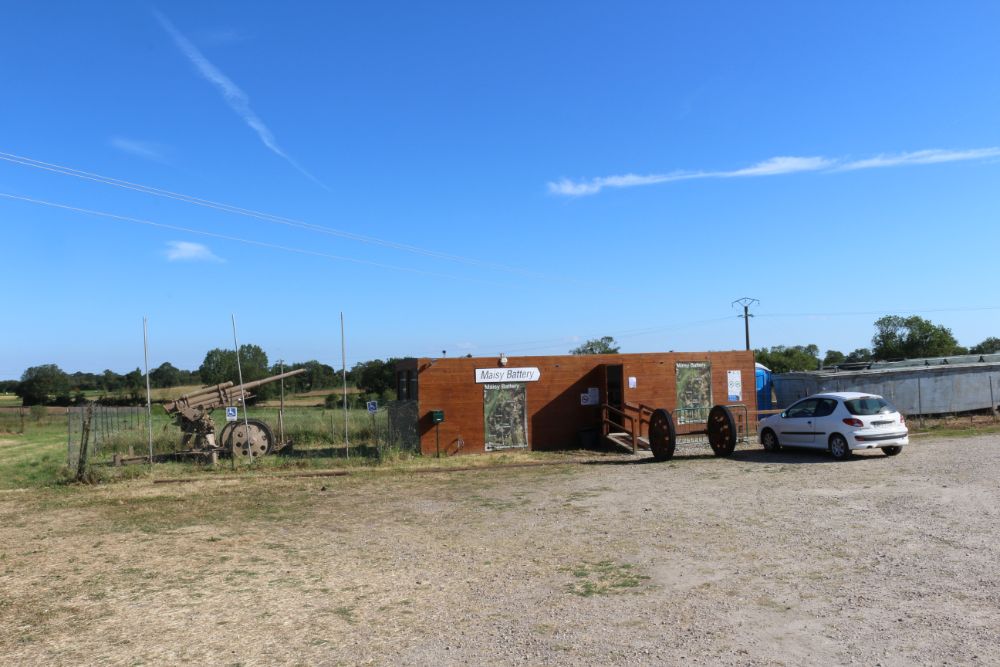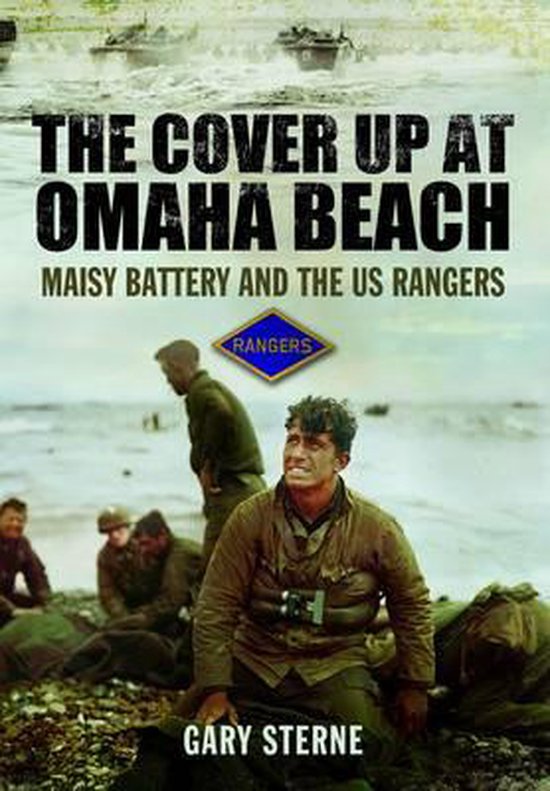Maisy Battery
Prologue
How an unknown German artillery battery could shell Omaha Beach until three days after D-Day.
On D-Day,the American Rangers, specially trained elite soldiers, captured in a spectacular way Pointe du Hoc, a cliff of over 30 metres high between Omaha Beach and Utah Beach.Pointe du Hoc had been designated as one of the prime targets for the landings in Normandy on 6 June 1944 by the Supreme Commander Dwight D.Eisenhower. According to allied intelligence services, there were six 155mm howitzers, but when the Rangers took the Pointe du Hoc it turned out that the German artillery was not present. Still Omaha Beach and to a lesser extent Utah Beach, were shelled for days by enemy artillery fire. The American invaders initially had no idea where the fire came from.
On a rainy day in January, 2004, British amateur historian Gary Sterne was searching for a good location near the village of Grandcamp-Maisy in order to start a museum. Sterne is himself an avid collector of military relics from the Second World War. He already possessed a large collection of American and German military stuff that all had to do with D-Day. He had among other things an unofficial map of the area of Omaha Beach. He had found the map in a crate in which was an American uniform he had bought. On the map, that was not very interesting generally, a point was marked with the words "area of high resistance". During his trip in Normandy, Sterne ran into the location that was marked on the map. He found concrete platforms but he had no idea what they were. On further investigation they turned out to be roofs of bunkers.
Gary Sterne didn't know exactly what he had discovered but he knew that it was a large complex because around the bunkers lay an undeveloped, haggard and overgrown area of at least 15 acres. In the months following his discovery he started to buy the ground that had no fewer than 27 different owners. He bought it piece by piece and in 2006 he had the buildings and trenches cleared from bushes and earth. It turned out that Gary Sterne had discovered the reasonably well conserved remains of the German Widerstandsnester 83 and 84, or WN83 and WN 84. They were also known as La Martiniere and Les Perruques after the small roads where the WNs were located. The two "resistance nests" would be known to the Americans as the Maisy Battery and to the French as Batterie de Maisy.
Gary Sterne gained recognition from the international press for rediscovering the historically very interesting location but because WN 83 and WN 84 had remained hidden for all those years the complex was quite unknown. Nevertheless, Sterne opened the Maisy Battery in 2007 for the public. In that year the place received international attention because German 150 mm howitzers, which had been reused after the war by the Polish and Russian armies, were placed on the location in 2008 but after this the attention quickly diminished.
Definitielijst
- D-Day
- The day of the long awaited invasion of western Europe in Normandy, France, 6 June 1944. After a long campaign of deception the allies attacked the coast of Normandy on five beaches to begin their march on Nazi Germany. Often explained as Decision Day, though this is entirely correct. The D stands for Day as generally used in military language. In this case it means an operation beginning on day D at hour H. Hence “Jour J“ in French.
- resistance
- Resistance against the enemy. Often also with armed resources.
Images
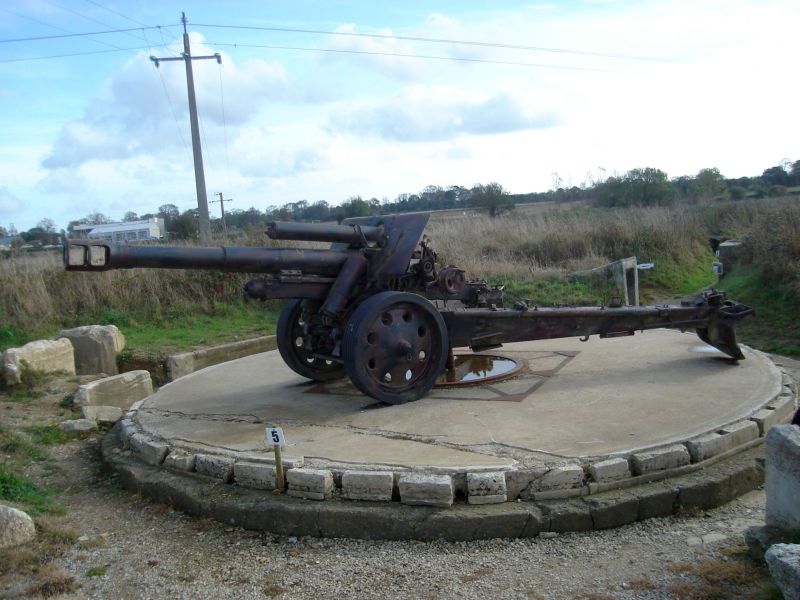 One of the Czech 150mm howitzers that were placed in 2008 in the dug out positions of Maisy Battery. Source: P. Kimenai.
One of the Czech 150mm howitzers that were placed in 2008 in the dug out positions of Maisy Battery. Source: P. Kimenai.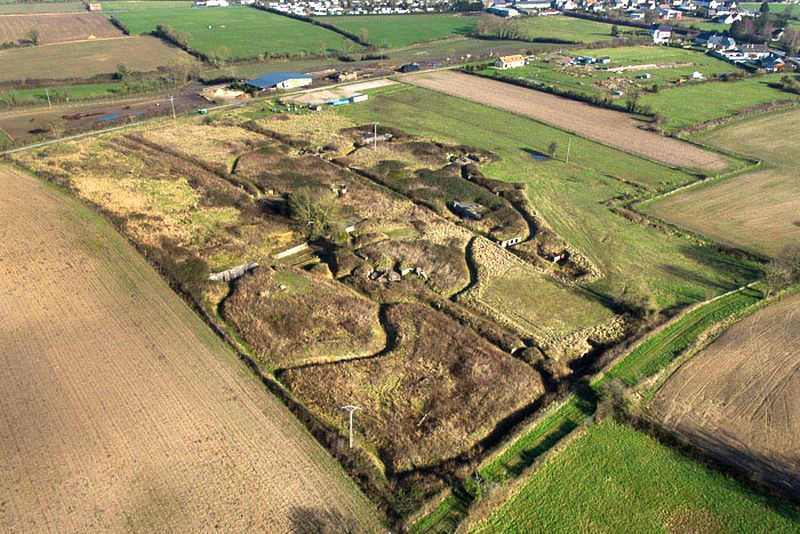 Air picture of Maisy Battery. Source: Maisy Battery.
Air picture of Maisy Battery. Source: Maisy Battery.From 1942 on
From 1942 on, the Wehrmacht had Widerstandsnester 83 and 84 built in utmost secrecy by foreign forced labourers and the battery was not known even to the local population. The artillery battery was located six kms southwest of the Pointe du Hoc, near Grandcamp-Maisy and it comprised six French 155mm howitzers placed on specially constructed platforms, a confiscated allied 25 pounder gun and two 50mm antitank guns. The buildings of the complex consisted, among others, of a double type 502 personnel bunker used as a staff bunker, two double type 622 personnel bunkers, an anti aircraft radar control centre, two bomb proof Vf7b SK munition bunkers, an officers' building, a hospital, a radio building, four storage bunkers, a kitchen/mess building, a water storage facility and shelters. Most of these structures were built according to a German standard. The type 622 personnel bunker for 20 men was a standard bunker of which the Germans constructed 1,722 as part of the Atlantikwall. Maisy Battery was located very strategically, below ground level, in the gently sloping Normandy countryside behind the cliffs and dunes.
On D-Day, 6 June 1944, Maisy Battery was manned by a 450 men German garrison that belonged to the 352. and 716. Infanterie-Divisionen. On top of that WN 83,together with WN 84 that lay directly beside it and that had four 105mm light field howitzers, was protected from 3 June 1944 on by an air defence unit. This unit had twelve 88mm and 20mm Flugabwehrkanone (Flak). The Maisy battery, which could shell the beaches with the allied code names Utah Beach and Omaha Beach, had not been discovered during the allied reconnaissance flights and wasn't registered on American and British staff maps. Besides, the battery was missed during the days immediately preceding D-Day, when the allied air forces bombed German positions on the northern side of the Normandy coast. On top of this, on D-Day itself the allied bombers as well as the allied ships missed Maisy Battery once more, during the bombardments preceding the actual landings. This was mainly due to the fact that the allies were unaware of the existence of the artillery battery but is was also a result of the fact that the battery was well camouflaged and the before mentioned excellent strategic location.
After the Rangers had conquered the Pointe du Hoc on D-Day, they discovered that there weren't any guns on the strategic cliff. They only found several 20mm Flak guns and several machine gun nests. On the cliff, that resembled a lunar landscape by the many allied shells and bombs that had hit it, there were four bunkers for 105 mm naval guns. Two of these concrete structures were still under construction, but in none of these six bunkers were guns. The six 155mm howitzers that the allies thought were present on the cliff would never have fitted in the bunkers. Despite the fact that the Rangers conquered Pointe du Hoc on D-Day itself and there were no heavy calibre guns on the cliff, the landing forces on Omaha Beach and to a lesser extent on Utah Beach, were shelled from the moment that the first soldiers set foot ashore. At first, the Americans hadn't a clue as to where the battery was located that fired these shells.
Definitielijst
- D-Day
- The day of the long awaited invasion of western Europe in Normandy, France, 6 June 1944. After a long campaign of deception the allies attacked the coast of Normandy on five beaches to begin their march on Nazi Germany. Often explained as Decision Day, though this is entirely correct. The D stands for Day as generally used in military language. In this case it means an operation beginning on day D at hour H. Hence “Jour J“ in French.
- Flak
- Flieger-/Flugabwehrkanone. German anti-aircraft guns.
- machine gun
- Machine gun, an automatic heavy quick firearm.
- radar
- English abbreviation meaning: Radio Detection And Ranging. System to detect the presence, distance, speed and direction of an object, such as ships and airplanes, using electromagnetic waves.
- Wehrmacht
- German armed military forces, divided in ground forces, air force and navy.
Images
On D-Day
On D-Day, the Rangers had subdued Pointe du Hoc within 30 minutes after the initial landings. Because they had strayed off course and because of problems with their radio equipment, the news of the capture was sent too late to the 500 reinforcements. Because of this the Rangers landed on Omaha Beach instead of climbing the cliff. The reinforcements forced a breakthrough on Omaha Beach so that they and the other Americans, mainly infantry, could attack the German defenders from behind and neutralize them. Before this breakthrough, thousands of US soldiers had become casualties on "Bloody Omaha". The Rangers moved inland after D-Day and could only reinforce their comrades on Pointe du Hoc on 8 June. All this time the Pointe du Hoc had been held by the Rangers despite fierce German counter attacks.
The day before, on June 7, 1944, Rangers that were patrolling the coast road had found six 155 mm howitzers in an apple orchard. This artillery was located approximately 500 metres inland south of the Pointe du Hoc and hadn't been discovered by allied reconnaissance flights because of excellent camouflage. Because the howitzers weren't directly equipped or guarded the Rangers could neutralize them fairly easy with the aid of thermite grenades. With the neutralisation of these howitzers, the positions at Point du Hoc and the elimination of several other coast batteries by allied naval guns the Americans thought that they had all German artillery under control, but Omaha Beach was still being shelled regularly by medium artillery. By sounding and calculations they could ascertain where the German shells came from.
On June 9, 1944 American troops that had stormed Omaha Beach, mainly soldiers from the 116th Infantry Regiment supported by the 58th Armored Field Artillery Battalion, moved from Grandcamp-Maisy in a southern direction to Isigny-sur-Mer. They left the Maisy Battery to the Rangers. The infantry soldiers were shelled by the guns of La Martiniere or WN 84. Preceding the attack of the Rangers the guns of the 58th Armored Field Artillery Battalion pounded the German positions of the Maisy Battery and the remaining Flak of the air defence unit. The attack itself was executed by the A-, C- and F-Companies of the 5th Ranger Battalion that were supported by four 81 mm mortars. Additional support was by two halftracks with 75 mm cannon of the 2nd Ranger Battalion and Company B of the 81st Chemical Weapons Battalion, that had 4.2in mortars. The Rangers were commanded by Major Richard Sullivan.
The attack was initiated by A-company, that stormed La Martiniere and F-Company, that attacked Les Perruques.B-Company was kept in reserve. The Rangers didn't meet a lot of resistance and could proceed through the trenches under cover of the mortars and with the aid of hand grenades. The trenches hadn't suffered a lot of damage by the previous allied bombardments. The German soldiers they encountered tended to surrender quickly until four officers, possibly but not probably SS, appeared that shot a few of their own who were surrendering. By doing so the officers forced the defenders to continue fighting, which they did until they were killed by the Rangers. Because of this, a lot of Germans were unnecessarily killed. After a five hour battle, the Rangers took Maisy Battery and took prisoner a 130 to 150 Germans.
Definitielijst
- cannon
- Also known as gun. Often used to indicate different types of artillery.
- D-Day
- The day of the long awaited invasion of western Europe in Normandy, France, 6 June 1944. After a long campaign of deception the allies attacked the coast of Normandy on five beaches to begin their march on Nazi Germany. Often explained as Decision Day, though this is entirely correct. The D stands for Day as generally used in military language. In this case it means an operation beginning on day D at hour H. Hence “Jour J“ in French.
- Flak
- Flieger-/Flugabwehrkanone. German anti-aircraft guns.
- infantry
- Foot soldiers of a given army.
- Ranger
- American name for a specially trained soldier (similar to commando).
- Regiment
- Part of a division. A division divided into a number of regiments. In the army traditionally the name of the major organised unit of one type of weapon.
- resistance
- Resistance against the enemy. Often also with armed resources.
Images
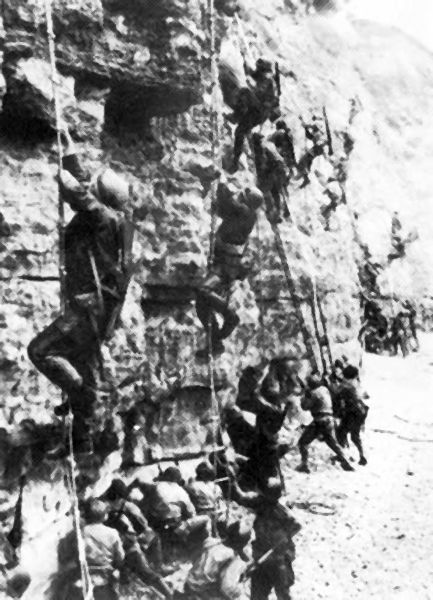 US Rangers in action on Pointe du Hoc on D-Day. Source: D-Day Overlord.
US Rangers in action on Pointe du Hoc on D-Day. Source: D-Day Overlord.Captain John Raaen
Captain John Raaen of the 5th Rangers Battalion gave the following account of the capture of Maisy Battery: "Crossing through the hedgerows and fields we were taken under longe-range machine-gun fire from our right several times. However, we were beyond tracer burn-out and the Germans were never able to reach us. Because of the extensive mine fields protecting the German strongpoint, Major Sullivan decided to attack in a column of companies with A-Company in the lead followed by C-Company with F-Company in reserve. The 58th Armored Field Artillery Battalion bombarded the Maisy positions in preparation for the 5th Ranger attack. Support during the attack was provided by the 81st`4.2in mortars, the two 75mm cannon mounted on the 2nd Rangers` halftracks and the four 81mm mortars. Companies A and F moved down the dirt road just north of gridline 92. This area is quite swampy and in this swampy area they came across some dead American paratroopers who had been dropped miles from their intended drop zones. When opposite (north of) La Martiniere and Les Perruques, the companies wheeled to the left with A-Company attacking La Martiniere and F-Company, Les Perruques. Meanwhile, C-Company with the cannon platoon from the 2nd Rangers proceeded directly south from Maisy, wheeled right, attacking Les Perruques from the south-east. Major Sullivan controlled the battle from one of the halftracks accompanying C- and D-Companies. The attack progressed well with some of the German defenders laying down their weapons and surrendering. However, some German officers, possibly SS, began shouting and shooting some of their own in the back. Despite the mine fields and stubborn resistance, the strongpoint was succesfully captured. Ace Parker, the A-Company Commander, later told me that, as far as he was concerned, the fight at Maisy was far worse than the Omaha Beach landings of four days before."
After the capture of Maisy Battery by the Rangers, the five still intact 155mm howitzers were made unoperable. Although the battery had shelled Omaha Beach and the ships in front of it for days, the Rangers found over 180 tonnes of ammunition and a large supply of food and water that could have sustained WN 83 and WN 84 for several additional weeks. Because the air defence of Maisy Battery had been neutralized for the main part and the days of shelling and bombing of the Widerstandsnester from June 6, 1944 on had had a demoralizing effect on the defenders, the Rangers could take Maisy Battery relatively easy. The capture of the German stronghold had cost 18 dead and wounded American elite soldiers. Already before the end of the war, Maisy Battery, for still unknown reasons, was covered with metres of earth by American bulldozers.
Definitielijst
- cannon
- Also known as gun. Often used to indicate different types of artillery.
- mine
- An object filled with explosives, equipped with detonator which is activated by either remote control or by colliding with the targeted object. Mines are intended to destroy of damage vehicles, aircrafts or vessels, or to injure, kill or otherwise putting staff out of action. It is also possible to deny enemy access of a specific area by laying mines.
- paratroopers
- Airborne Division. Military specialized in parachute landings.
- Ranger
- American name for a specially trained soldier (similar to commando).
- resistance
- Resistance against the enemy. Often also with armed resources.
- shelling
- Indication for shooting targets with grenades. Both from artillery and armoured artillery.
Images
After the Second World War
After the Second World War the conquest of Pointe du Hoc by the Rangers was thoroughly covered in literature and commemorations. The coverage was so thorough that the American Battle Monuments Commission preserved the cliff, including the bunkers and the lunar landscape, as an eternal memory of the power of the force of the allied invasion and the courage of the attackers. It was indeed a spectacular and daring assault that was crowned with success. Tactically spoken the conquest of the protruding cliff was of no value because there were no guns.In contrast with this the capture of the Maisy Battery was of great tactical importance because this neutralized the German artillery in the vicinity of Omaha Beach. The invasion beach was used for months to land enormous amounts of troops and supplies that ultimately would lead to the demise of the Third Reich. Maisy Battery was, however, buried under earth and its existence soon sank in oblivion. If Gary Sterne hadn't discovered the complex and had it excavated, the numerous visitors of the landing beaches of Normandy wouldn't even know of the existence and importance of the German battery.
Despite all the trouble of Gary Sterne, Maisy Battery doesn't receive the attention of, for instance, Pointe du Hoc and other bunker complexes in Normandy from the period 1940/1945.While you are reading this, the museum pieces from La Martiniere and Les Perruques are rusting away and after a rain shower the trenches become muddy places that can't be visited without boots. The ticket selling station that doubles as a souvenir shop, still is the temporary building that stood there since 2007.
After the short lived rebirth the Maisy Battery seems to slip away into oblivion for a second time in a salty Norman mist of unfamiliarity.
Definitielijst
- invasion
- Armed incursion.
Images
Information
- Article by:
- Peter Kimenai
- Translated by:
- Peter ter Haar
- Published on:
- 19-01-2025
- Feedback?
- Send it!
